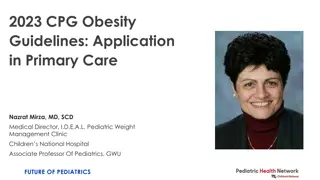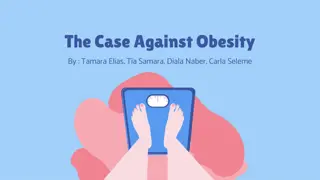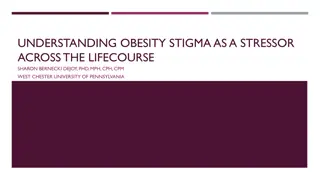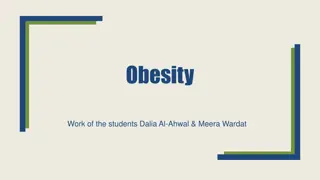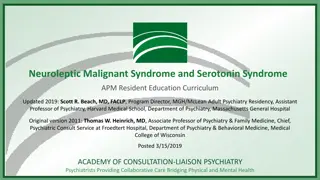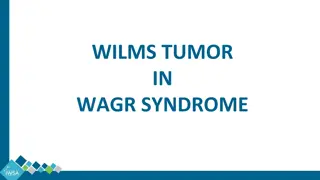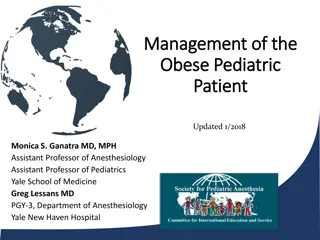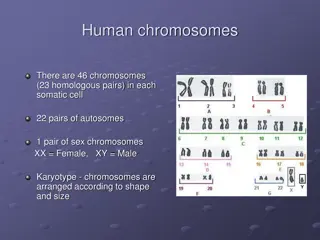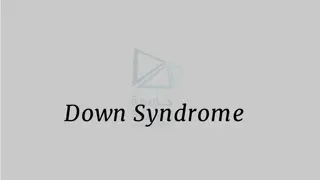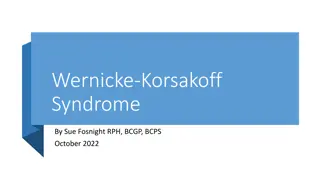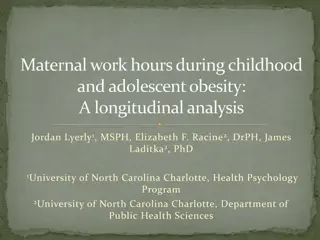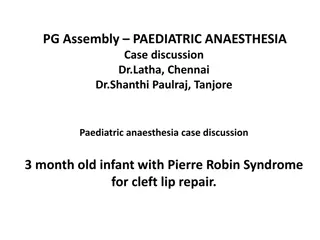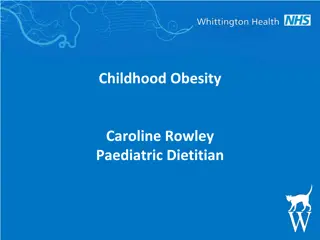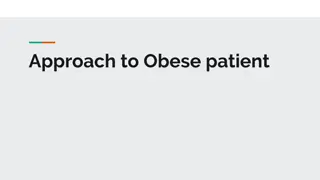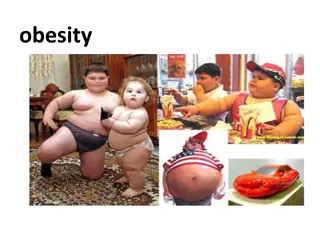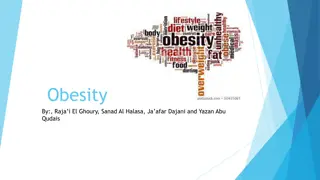Obesity Hypoventilation Syndrome: Diagnosis and Mechanisms
Obesity Hypoventilation Syndrome (OHS) is a condition characterized by hypoventilation during sleep due to obesity-related changes in the respiratory system. Diagnosis requires a high index of suspicion and involves criteria such as BMI>30, daytime hypercapnia, and sleep-disordered breathing. The pathophysiology involves mechanisms like reduced lung compliance, gas trapping, and increased respiratory drive. Patients with OHS may present with acute decompensation, prompting referral for evaluation and management.
Download Presentation

Please find below an Image/Link to download the presentation.
The content on the website is provided AS IS for your information and personal use only. It may not be sold, licensed, or shared on other websites without obtaining consent from the author.If you encounter any issues during the download, it is possible that the publisher has removed the file from their server.
You are allowed to download the files provided on this website for personal or commercial use, subject to the condition that they are used lawfully. All files are the property of their respective owners.
The content on the website is provided AS IS for your information and personal use only. It may not be sold, licensed, or shared on other websites without obtaining consent from the author.
E N D
Presentation Transcript
Carol Liz Robinson, ST3
Carol Housebound Poor exercise tolerance Increasingly dependent for ADLs GP label asthma Treatment resistant hypertension Investigated by Endocrine ?Cushing's T2DM Recurrent cellulitis Umbilical hernia repair Pulmonary Embolus Apr 20
Admission history 166 ED presentations Desaturating and raised C02 Bicarb >30 and pC02 7.1 Decompensated T2RF 2018 Sleep studies 2019 AHI 83.6 Jan 2020 ITU admission with decompensated T2RF
Definition - BMI>30 OHS - Daytime hypercapnia 6 kPa -Sleep disordered breathing
Prevalence 1 in 10 adults obese OHS ?0.4% of population Males, 52 FEV1/FVC 0.77 MRCD 3 or 4 Bicarb 32 At diagnosis
How does it present? Acute decompensation Symptoms prompting referral to our services
How is it diagnosed? High index of suspicion Definition - BMI>30 Serum bicarb - Daytime hypercapnia 6 kPa - Sleep disordered breathing ABG Sleep studies
Phenotype/pathophysiology 3 mechanisms Obesity Changes within respiratory system 1 2 Changes in respiratory drive 3 Sleep disordered breathing
Phenotype/pathophysiology 3 mechanisms Obesity Changes within respiratory system 1 Reduced lung compliance Gas trapping V/Q mismatch Deposition of adipose tissue Reduced lung volumes Dec diaphragm movement Increased respiratory drive
Phenotype/pathophysiology 3 mechanisms 2 Changes in respiratory drive Hypoventilation during REM sleep Increased respiratory drive LEPTIN AXIS
Phenotype/pathophysiology 3 mechanisms 3 Sleep disordered breathing Obstruction of upper airways Respiratory depression Raised C02
Co-morbidities Hypertension LVH IHD Pulmonary hypertension Congestive cardiac failure Frailty (+T2DM, mental health problems, osteoporosis, cancer etc etc)
Treatment CPAP VS NIV NIV FEV1, FVC and 6 minute walk LV and PASP CPAP
Longer term Acute Steroids????? Reasons for decompensation Rehab?? -Pneumonia, VTE etc Cardiovascular etc - Diuresis COMPLIANCE - Medications
With Treatment Initiation Pre-treatment Referral source: patient, bed partner, other physician Heated humidification Assessment of knowledge of OSA and perception of CPAP treatment Phone call/follow-up first wk of treatment Factors affecting compliance Involvement of bed partner in education and treatment initiation Assessment of CPAP use and associated outcomes Evaluation of patient awareness and assessment of symptoms Assessment of patient perception of treatment and symptom-related treatment response How does patient handle challenges in life active or passive problem solving? Evaluation of bed partner perception of treatment Assessment of claustrophobic tendencies Troubleshoot problems immediately especially during the first week of treatment Evaluation of nasal resistance Evaluate for the presence of residual sleepiness and, if present, initiate treatment Patient-centered mask and device selection Retitration if presence of residual events suspected Exposure to CPAP before initiation of therapy
Improving compliance Humidification Masks Dexterity Behavioural - Education - Follow up phone calls - Supported (ie inpatient) initiation
References Gay PC, Herold DL, Olson EJ. A randomized, double-blind clinical trial comparing continuous positive airway pressure with a novel bilevel pressure system for treatment of obstructive sleep apnea syndrome.Sleep 2003;26:864 869. [PubMed] [Google Scholar] Terri E. Weaver, Ronald R. Grunstein Adherence to Continuous Positive Airway Pressure Therapy:The Challenge to Effective Treatment Proc Am Thorac Soc. 2008 Feb 15; 5(2): 173 178.doi:10.1513/pats.200708-119MG PMCID: PMC2645251 Yasser Sakr1, Ilmi Alhussami, Rahul Nanchal, Richard G Wunderink,Tommaso Pellis,Xavier Wittebole, Ignacio Martin-Loeches, Bruno Fran ois, Marc Leone,Jean-Louis Vincent, Intensive Care Over Nations Investigators Being Overweight Is Associated With Greater Survival in ICU Patients: Results From the Intensive Care Over Nations Audit Juan F. Masa,Jean-LouisP pin,Jean-Christian Borel, Babak Mokhlesi, Patrick B. Murphy, Maria ngelesS nchez-Quiroga Obesity hypoventilation syndrome European Respiratory Review 2019 28:180097; DOI: 10.1183/16000617.0097-2018



